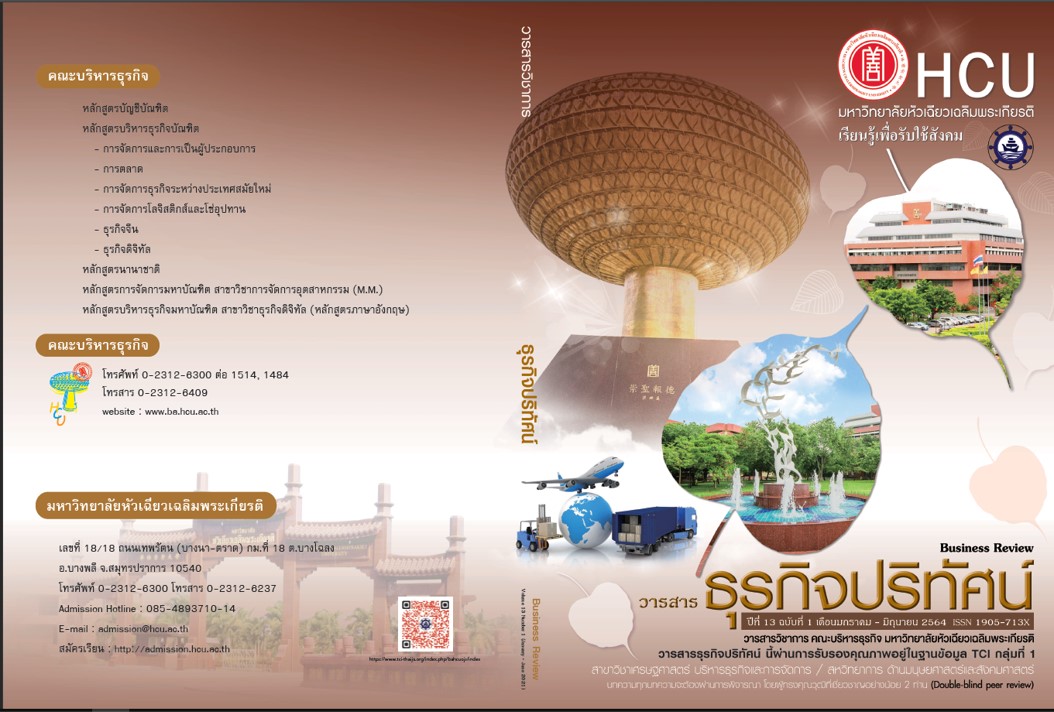A Comparative Study of The Transmission in The Green Business Strategy between Starbuck Coffee Shop and Café Amazon
Keywords:
Communication, Business strategy, Green businessAbstract
The purpose of this research is to compare the communication of green business strategies the green business strategies communication and consumer perceptions of the business operations of Starbucks coffee shops and Café Amazon.This research uses qualitative research method for collecting data which consists of content analysis and in-depth interview. There are 2 parts of conducting research. Part 1 which is studied with content analysis and content creation strategies on Facebook fan page. The data is collected from 1 July 2018 to 30 June 2019. Part 2 in-depth interviews with 20 informant groups using snowball sampling techniques. According to studies, it has been found that1)In terms of green business strategy communication of Starbucks coffee shop and Cafe Amazon, The Starbucks has 17 percent more massages, which communicate green business strategies communication, than Amazon Café. 2) The consumers perceived the green business operation of Starbucks coffee shops in all 5 green supply chain activities.For Café Amazon, it was found that consumers only perceived green supply chain activities in only 3 aspects.
References
กาญจนา ทวินันท์ มนตรี ธรรมพัฒนากูล สิทธิชัย ชูสุวรรณ์ และสุกัญญา โตแทนสมบัติ. (2562). คุณภาพการให้บริการและความรับผิดชอบต่อสังคมที่ส่งผลต่อความพึงพอใจของลูกค้าร้านกาแฟสตาร์บัคส์สาขาเซ็นทรัลพลาซ่า จังหวัดพิษณุโลก. วารสารธุรกิจปริทัศน์, 11(1), 35-54.
กรมส่งเสริมอุตสาหกรรม. (2561). อุตสาหกรรมสีเขียวในประเทศไทยต่อการเจริญเติบโตอย่างยั่งยืน.สืบค้นเมื่อ30 พฤษภาคม 2562,จาก กรมส่งเสริมอุตสาหกรรมเว็บไซต์: https://dip-sme-academy.com/knowleagehub/article/182-อุตสาหกรรมสีเขียวในประเทศไทยต่อการเจริญเติบโตอย่างยั่งยืน
ชลธิศ ดาราวงษ์. (2558). การเพิ่มสมรรถนะการดูดซึมความรู้ให้กับทีมพัฒนาผลิตภัณฑ์สาหรับ SMEs ไทย. วารสารบริหารธุรกิจ เศรษฐศาสตร์และการสื่อสาร, 10(1), 4-14.
ภัทราพร ยาร์บะระ. (2017). สตาร์บัคส์ เพราะกาแฟราคาถูกมีต้นทุนแฝง!.สืบค้นเมื่อ30 พฤษภาคม 2562, จากเดอะสแตนดาร์ด เว็บไซต์ : https://thestandard.co/opinion-unconventional-business-starbucks-cost/
ภาณุมาศ มนัสประเสริฐ, ส. พ., สุชาดา สะวะพรม และ พิทักษ์ ศิริวงศ์. (2559). รูปแบบ กลยุทธ์ และการสื่อสารความรับผิดชอบต่อสังคม ขององค์กรธุรกิจที่ปรากฏอยู่ในหนังสือบ้านและสวน. Veridian E-Journal Silpakorn University, 9 (1 ), 1381-1398.
มรกต กำแพงเพชร สวรรยา ธรรมอภิพล และนรินทร์ สังข์รักษา. (2562). คุณลักษณะผู้ประกอบการเกษตรกรที่ประสบความสำเร็จในธุรกิจเกษตรสีเขียว. วารสารธุรกิจปริทัศน์, 11(1), 262-275.
วีรวัฒน์ มณีสุวรรณ และ ธนัญญา วสุศรี. (2557). การจัดการกรีนโลจิสติกส์กับศักยภาพของผู้ให้บริการโลจิสติกส์ไทย. วารสารวิจัยและพัฒนา มจธ, 37(2), 215-226.
ศิระ ศรีโยธิน. (2561). เครื่องมือการสื่อสารการตลาดเพื่อการสร้างแบรนด์องค์กร. Veridian E-JournalSilpakorn University,11(1), 2247-2263.
คมศักดิ์ สว่างไสว. (2016). ธุรกิจสีเขียว (GREEN BUSINESS).สืบค้นเมื่อ 30พฤษภาคม2562, จากศูนย์วิจัยนโยบายด้านเศรษฐกิจสีเขียว เว็บไซต์ : https://progreencenter.org/2016/02/09/%E0%B8%98%E0%B8%B8%E0%B8%A3%E0%B8%81%E0%B8%B4%E0%B8%88%E0%B8%AA%E0%B8%B5%E0%B9%80%E0%B8%82%E0%B8%B5%E0%B8%A2%E0%B8%A7-green-business/
สำนักโลจิสติกส์ กรมอุตสาหกรรมพื้นฐานและการเหมืองแร่. (2558). การจัดการโลจิสติกส์และโซ่อุปทานสีเขียว:นวัตกรรมและการปรับเปลี่ยนเพื่อสร้างศักยภาพทางธุรกิจ. กรุงเทพฯ : บริษัท จรัลสนิทวงศ์การพิมพ์จำกัด.
อรรถพล ธรรมไพบูลย์ นุช สัทธาฉัตรมงคล และลาวรรณ์ อนันต์ชลาลัย. (2559). การรับรู้เกี่ยวกับการจัดการโซ่อุปทานสีเขียวและผลกระทบต่อภาพลักษณ์องค์กร. วารสาร ธุรกิจปริทัศน์, 8(2),109-128.
Danciu, V. J. R. E. J. (2018). The Changing Focus of Green Marketing: From Ecological to Sustainable Marketing (III). The Romanian Economic Journal, 21(68), 121-144.
Gálvez-Rodriguez, M. D. M., Caba-Perez, C., & López-Godoy, M. (2014). Facebook: A new communication strategy for non-profit organisations In Colombia. Public Relations Review, 40(5), 868-870.
Guide, V. D. R., & Srivastava, R. (1998). Inventory buffers in recoverable manufacturing. Journal of Operations Management, 16(5), 551-568.
Huang, S.-L., & Chen, C.-T. (2018). How consumers become loyal fans on Facebook. Computers in Human Behavior, 82, 124-135.
Li, G., Shao, S., & Zhang, L. (2019). Green supply chain behavior and business performance: Evidence from China. Technological Forecasting and Social Change, 144, 445-455.
Liu, Y., Zhang, Y., Batista, L., & Rong, K. (2019). Green operations: What's the role of supply chain flexibility?.International Journal of Production Economics, 214, 30-43.
Nisachon Leerattanakorn. (2015). GREEN CONSUMER BEHAVIOR: CHIANG MAI THAILAND. Paper presented at the Proceeding of International Academic Conference 18th,(pp 406-422), London.
Radzi, N. A. A., Harun, A., Ramayah, T., Kassim, A. W. M., & Lily, J. (2018). Benefits of Facebook fan/brand page marketing and its influence on relationship commitment among Generation Y: Empirical evidence from Malaysia. Telematics and Informatics, 35(7), 1980-1993.
Verburg, R., Rahn, E., Verweij, P., Vn Kuijk, M., & Ghazoul, J. (2019). An innovation perspective to climate change adaptation in coffee systems. Environmental Science & Policy, 97, 16-24.
Downloads
Published
How to Cite
Issue
Section
License
All articles published in the Business Administration and Management Journal Review are copyrighted by the journal.
The views and opinions expressed in each article are solely those of the individual authors and do not represent those of Huachiew Chalermprakiet University or any other faculty members. Each author is fully responsible for the content of their own article. Any errors or issues found are the sole responsibility of the respective author.




